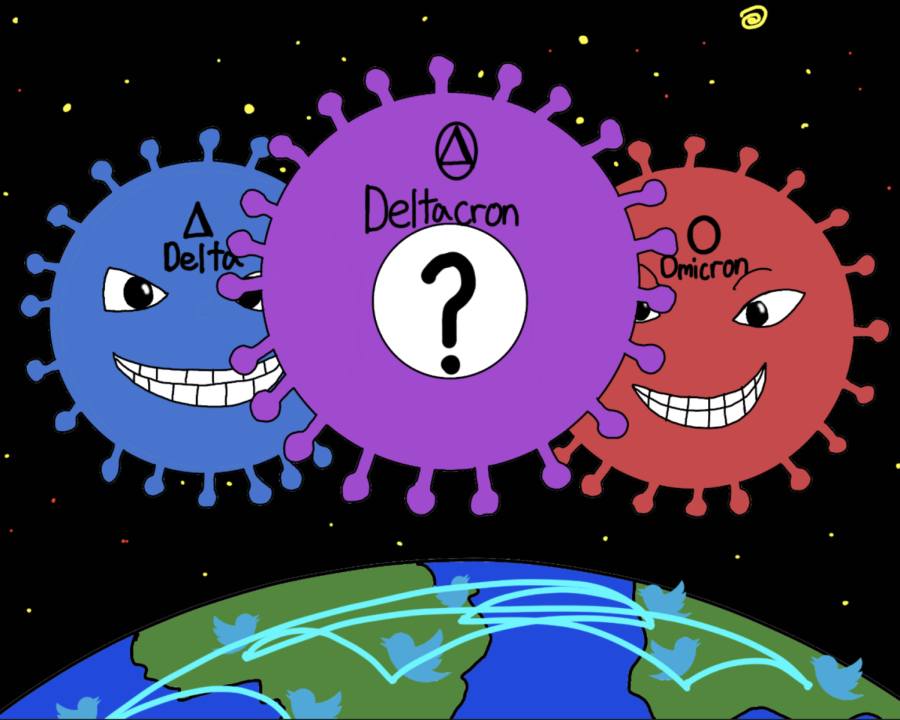Deltacron misinformation goes “viral”
Jan 27, 2022
On Jan. 7, worrying news spread across the world as researchers from the University of Cyprus announced the discovery of a new COVID-19 genome— a combination of Delta and Omicron. This new recombinant strain, which was dubbed “Deltacron,” made headlines as the lead scientist, Dr. Leondios Kostrikis, claimed it had already infected 25 people.
The term Deltacron soon began trending on Twitter, but many debates questioning the validity of Deltacron surfaced within the science community. Renowned scientists such as Dr. Krutika Kupalli, a COVID-19 expert at the World Health Organization (WHO), believed Deltacron to be a case of laboratory contamination rather than a legitimate new strain. In fact, due to the backlash from the scientific community, the original researchers removed their publications from public view.
“When I first heard about the emergence of Deltacron, I was a bit worried because there were people freaking out over it on social media,” Brandon Choi (10), a daily social media newsreader, said. “But after I looked through some news sources online, I quickly saw many expert opinions calling this strain illegitimate, so I was not too worried afterward.”
Although research-oriented institutions such as universities are known for their credibility and generally trusted with providing correct information, it is not always the case. There are many factors that cause misinformation to spread from academic sources, such as research bias, invalid data, improper wording, and in the case of Deltacron, a misconstrued hypothesis.
“I tend to believe the news I see online, and I definitely trusted the credibility of sources with academic backgrounds such as universities without asking questions,” Eric Cho (9), an aspiring STEM student, said. “Since so many people easily believe news from such sources, it is especially important for researchers to take special care when announcing news like Deltacron.”
Similar to Deltacron, the term Flurona, describing a recombinant strain between Influenza and COVID-19, recently made waves on social media. While research has confirmed that people are able to catch the flu and COVID-19 simultaneously, a plethora of people on social media platforms misinterpreted this information and instead spread false news about a new influenza-coronavirus strain.
“I think misinformation, especially regarding COVID-19, is really detrimental as it spreads unnecessary panic and fear among the public,” Sarah Yim (11), SCIC biology executive, said. “The rapid spread of the news of several false strains through social media platforms such as Twitter demonstrates how dangerously fast misinformation can disperse.”
Indeed, especially in recent years, misinformation and medical conspiracies have often led to increased numbers of medical skepticists. In fact, after the start of COVID-19, skeptics such as anti-maskers and anti-vaxxers regularly made headlines for disturbing public peace. Not only is this rise of scientific misconceptions dangerous for public health, but it is also often a highly divisive topic that ends up the topic of political and social debate.
“The consequences of misinformation, especially from trusted academic sources such as universities, can be severe,” Niko Lambert, AP Biology teacher, said. “So, the academic community should further embrace rigorous peer-review processes before publishing. As for laypersons, people should make sure not to take information at face value and double-check such information to see if it has been corroborated by multiple credible sources.”
Checking for credibility is currently easier than ever before, due to the great amount of easily accessible information on the internet. However, the same internet that allows for ease of access to information is a double-edged sword, as it also allows the quick spread of contested/false information. Despite such dangers, if students or even adults learn proper habits of fact-checking their information, the spread of misinformation such as Deltacron can be contained.







